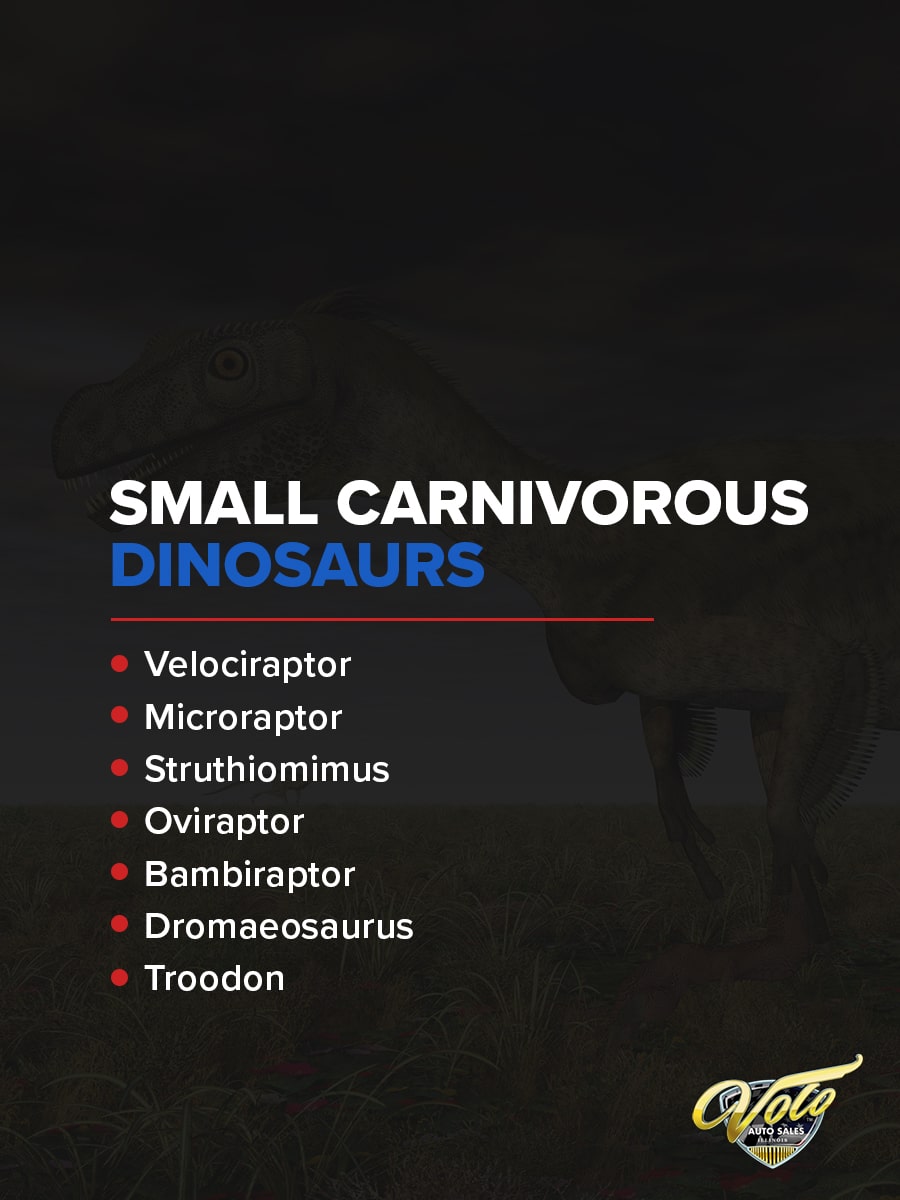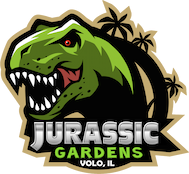
Carnivorous Dino Guide | Jurassic Gardens
Millions of years ago, the giant reptiles we know as dinosaurs inhabited the Earth. Many of them were theropods — or carnivores, scavenging and hunting for meat. From the small, speedy Velociraptors to the towering Tyrannosaurus rex, there was a fascinating array of different species. Here's your comprehensive guide to carnivorous dinosaurs.

The Evolution of Carnivorous Dinosaurs
Interestingly, when you look at the range of carnivorous dinosaurs, most of them fall into two categories — large and small. Middle-sized dinosaurs were hard to find. This is much different than the carnivorous mammal communities we see today, which is full of medium-sized animals that gradually grow larger across the spectrum.
Communities in the Serengeti of Africa have many predators and still boast a wide range of carnivore sizes, from small mongooses and medium-sized wild dogs to super-predator lions.
So what happened to all the medium-sized carnivorous dinosaurs?
One likely theory points to the rapid growth of juvenile carnivorous dinosaurs. A dinosaur like the Tyrannosaurus rex started growing quickly and would soon match the size of medium-sized, full-grown dinosaurs. The quicker, more agile T. rex would find smaller prey, while a fully-grown T. rex, with its sheer size and strength, would hunt larger dinosaurs.
The adolescent T. rex would, in simpler terms, outcompete the fully-grown middle-sized dinosaurs for prey, slowly edging them out of the food chain. The rapid growth of many carnivorous dinosaurs likely put medium-sized dinosaurs in a bad situation, leading to their relative exclusivity.
This is just one theory, of course — and others believe that we simply still haven't found the fossils of medium-sized carnivorous dinosaurs yet.
As of now, we can usually split the carnivorous dinosaurs into small and large categories. So which dinosaurs are carnivores?

Small Carnivorous Dinosaurs
When we think of carnivorous dinosaurs, we often think of those giant, towering beasts tramping across the landscape. We think of the monstrous creatures we've seen in classic films like “Jurassic Park.” But there were also smaller dinosaurs — some that were tiny — that shared the Earth with those behemoth dinosaurs. Here are some of those small carnivorous dinosaurs.
Velociraptor
Speaking of “Jurassic Park,” this is the dinosaur that stars in the movie. The film fictionalized these dinosaurs a bit, making them probably more clever and a little larger than they actually were.
In truth, Velociraptors were actually around the same size as a turkey. They definitely had some ferocious capabilities, however — the Velociraptor's sharp foot claws could grow to be 2.5 inches and be used to stab or hook prey to keep them from escaping. They also likely had feathers and arms that slightly resembled wings, though they couldn't fly.
Some see the Velociraptor as a kind of land eagle, chasing after prey with sharp claws and deadly precision. Using its tail for balance, the Velociraptor could move quickly after prey. If you traveled back in time and happened upon a Velociraptor, you'd probably find it resembling a giant bird.
Microraptor
As its name implies, the Microraptor was tiny — around 2 feet long. It also had four birdlike wings, and unlike the Velociraptors, Microraptors likely had the ability to fly. Weighing only a few pounds, these dinosaur birds still had a weapon that made them dangerous — a sickle-shaped claw on their feet.
Struthiomimus
Measuring 13 feet and weighing around 330 pounds, this dinosaur is bigger than some of the smaller dinosaurs but still tiny compared to the larger beasts. Moving on two legs, the Struthiomimus had a small head featuring a horned beak and no teeth. Its long neck made it resemble a reptilian ostrich. Because of the resemblance, its name can literally be translated to “ostrich mimic.”
Oviraptor
The Oviraptor, translating literally to mean “egg thief,” was 6 feet long and walked on its strong hind limbs. It had two slender, short arms with three sharp claws on each, probably used for slashing and ripping prey. The Oviraptor had no teeth but a beaked head and large eyes. The “egg thief” naming is a nod to its fossil discovery — the remains of the Oviraptor were uncovered with the remains of what were thought to be Protoceratops eggs.
Bambiraptor
A 17-year-old boy found these dinosaur bones buried in Montana. Little did he know he'd just uncovered an entirely new species — a small but fierce hunter that preyed on mammals and reptiles.
The Bambiraptor was very similar to a modern bird, with a feathered body and a brain matching the size of some birds today. It was 30 inches long and stood about a foot high. Its sharp second toe was likely used for hunting purposes.
Dromaeosaurus
The Dromaeosaurus, meaning “running lizard,” was a dinosaur with many unique features fit for a rabid hunter — sharp, backward-curving teeth, claws on its back feet for kicking and durable hind legs. As its name implies, this beast was a deadly predator when it picked up speed, having the multiple abilities of biting and clawing its victim in an attack.
Troodon
The Troodon is sometimes touted as the world's smartest dinosaur. Some pointed to its overly large brain as evidence, proposing that the Troodon possessed intelligence far beyond that of the average dinosaur. Though the Troodon may have been the smartest among its reptilian peers, its intelligence likely only amounted to that of a chicken.
Some even wondered what the big-brained Troodon would have become had evolution played a natural, continuous role without the impact of an extinction event. Dale Russell, a paleontologist, envisioned a tool-using “dinosauroid” with intelligence comparative to modern humans. Nonetheless, the potential of the Troodon is up for speculation. What we do know is that it was one of the most clever carnivorous dinosaurs of the era, using its big brain to hunt its prey.
Large Carnivorous Dinosaurs
Though small carnivorous dinosaurs are an important part of prehistoric history, our minds often tend to wander to the giant beasts we're familiar with — like the hulking, stomping T. rex.
Here are some of those classic giant carnivorous dinosaurs.

Saurophaganax
The Saurophaganax was a huge dinosaur, able to grow up to 40 feet in length. With its name translating to “king of the lizard eaters,” it certainly had the size to rival even the biggest dinosaurs of the era. The Saurophaganax likely fed on juvenile plant eaters and even fellow meat-eaters.
Carnotaurus
Another large, bipedal hunter, the 25-foot long Carnotaurus also had a distinctive, unique feature — two thick horns on its skull. The horns paired with its thick neck point to the theory that the Carnotaurus may have battled with competing males, using their horns to slam into one another and absorb the shock.

Daspletosaurus
The Daspletosaurus — “frightful lizard” — would tower over the average human at 30 feet in length. Living in the late Cretaceous period, its long and heavy tail helped it balance against its weighty torso. Like the T. rex, the Daspletosaurus moved on its strong back legs, using its sturdy jaw, sharp teeth and claws to attack prey.
Spinosaurus
The T. rex often gets the spotlight for being the most feared and dangerous dinosaur, but the Spinosaurus was maybe even more ferocious.
The discovery of the Spinosaurus dates back to 1915, when German paleontologist Ernst Stromer and his assistant found the partial skeleton in western Egypt. The skeleton was destroyed in 1944 during World War II — a bomb hit the museum in Germany where the bones were being housed, and the remains of the Spinosaurus were effectively lost to history. For a long while, all scientists had to base this beast off of was Stromer's descriptions.
Soon more bones were discovered, however, and the legend of the Spinosaurus started to become clearer. Its body could grow up to 60 feet long, with a skull that measured 6 feet. It could weigh up to 22 tons.
The Spinosaurus also had extraordinary features. Its head resembled a crocodile's, with a long, narrow snout, eyes near its nostrils and straight, conical teeth. Its neck was long like a crane's, but it had the hips of a whale and feet as flat as paddles. The teeth, neck and feet all pointed to one conclusion — the Spinosaurus could swim.

Tyrannosaurus Rex
Now for the dinosaur of all dinosaurs — Tyrannosaurus rex. Its name highlights its domination, translating to mean “king of the tyrant lizards.” And a king it was, using its unique abilities to wreak havoc on the prehistoric world.
Its size, power and apex-predator features made it one of the most fearsome creatures to ever live on Earth. New technology allows us to see more detail than ever about the T. rex, giving us valuable insight into how it lived. Here are some of the defining characteristics that sent the T. rex flying to the top of the dinosaur food chain:
- Size: The T. rex could reach up 40 feet in length — similar to that of a school bus. Almost everything the T. rex saw was fair game to eat, and it could roam the landscape free from worrying about other predators — except for maybe another T. rex.
- Power: The T. rex was built for deadly force — the muscles in its head allowed it to bite down with 6 tons of force, essentially destroying anything in its mouth with one chomp. Its 60 serrated teeth were each around 8 inches long. The T. rex's common technique was to use these knifelike teeth to gnash onto prey, throw them into the air and swallow them whole. Similar to alligators, the T. rex also had convenient cooling vents in its head to prevent its skull from overheating while chewing through prey.
- Smell: The T. rex used its enhanced sense of smell to track its prey and find mates. It may even have had the strongest sense of smell of all its dinosaur counterparts.
The T. rex wasn't perfect, of course. Several weaknesses may have helped desperate prey trying to flee. Infamously, its arms were tiny and perhaps useless — they could have been the unneeded leftovers from evolution. They may have also served small functions, such as slashing prey at close range.
The “king of tyrant lizards” was also slow, probably only being able to power-walk at around 12 miles per hour. Anything faster, and the T. rex would likely shatter the bones in its feet. Some scientists also claim that the T. rex wasn't actually a hunter — it merely scavenged on creatures that were already dead.
Aside from its weaknesses, its clear that the T. rex is one of the most powerful and famous of all known dinosaurs.

What Are the Top 10 Biggest Carnivorous Dinosaurs?
Now that you know some different kinds of carnivorous dinosaurs, you might be wondering which ones stood at the top of the food chain. Who were the biggest and most ferocious carnivores in the prehistoric world?
Below, explore the top 10 biggest carnivorous dinosaurs.
10. Deltadromeus
The Deltadromeus could reach nearly 25 feet in length, but its best feature was its speed. Though it was big, the Deltadromeus had long, delicate limbs that likely made it a swift runner. Its speed could have made it into a kind of giant raptor, racing after prey with agility and power.
9. Tarbosaurus
Scientists uncovered Tarbosaurus fossils that put this massive dinosaur at about 40 feet long, though future fossils that haven't been found yet could reveal an even bigger Tarbosaurus. This dinosaur is a close cousin to the Tyrannosaurus.
8. Mapusaurus
In 1995, the Mapusaurus species was discovered in a great heap of hundreds of bones in South America. It took years for scientists to put the pieces together and reveal what this dinosaur really was.
Weighing 3 tons and measuring 40 feet, it was clear the Mapusaurus was a prehistoric carnivorous giant. Because of the number of scattered bones in one area, many scientists think this species traveled in herds. Their collaborative hunting may have allowed them to take down huge dinosaurs of their era.
7. Saurophaganax
The Saurophaganax, as mentioned earlier, was a dinosaur that rivaled the size of a Tyrannosaurus rex, measuring 40 feet long and weighing 3 tons. It had the size and power to make nearly anything in its path prey.
6. Acrocanthosaurus
This dinosaur once stalked the grounds of present-day Texas, finding prey and using its huge size to its advantage. The Acrocanthosaurus weighed nearly 6 tons and was 35 feet long, rivaling some of the biggest dinosaurs of the prehistoric era. It was also likely the apex predator of its day, arriving much earlier than other giant dinosaurs. For a long while, the Acrocanthosaurus was likely the king of the dinosaurs.
5. Deinocheirus
Only part of this dinosaur was discovered in the Gobi desert, leaving scientists to piece together what they had to construct a clearer picture of this giant beast. It measured around 36 feet long and over 13,000 pounds, making it one of the biggest dinosaurs ever.
This dinosaur also looked different from many of the others, with a humped back and two 8-foot-long arms that boasted three 8-inch claws.
4. Carcharodontosaurus
This dinosaur's skeleton was also destroyed in a bombing — the museum in Munich that was storing the bones was hit, wiping out the evidence of the Carcharodontosaurus. A new skeleton was uncovered in 1995, however, finally solving the mystery of the giant dinosaur.
The Carcharodontosaurus was 45 feet long, with a 5.5-foot-long skull and 6-inch serrated teeth.
3. Tyrannosaurus Rex
Because of its notoriety, many think the T. rex is the biggest of the carnivorous dinosaurs. In truth, it isn't even the second largest. That doesn't take away from its unusually ferocious features, though, with its vented skull, powerful bite and a length matching that of a school bus.
2. Giganotosaurus
Over 40 feet long and weighing over 10 tons, this dinosaur was even bigger than the hulking T. rex. The Giganotosaurus was probably faster than a T. rex, too, being able to reach speeds of up to 20 mph. There's evidence showing that these creatures may have preyed on other huge dinosaurs like the Argentinosaurus, perhaps traveling in packs to take down their prey.
Even with the huge dimensions of the Giganotosaurus, it still remains smaller than one last dinosaur.
1. Spinosaurus
Which is the biggest carnivorous dinosaur?
The Spinosaurus was the largest known dinosaur, growing up to 60 feet long and weighing 22 tons. Its semiaquatic nature allowed it to hunt in water and on land. With interesting features like a sail on its back and its unusual, crocodile-like snout, the Spinosaurus is also one of the most fascinating dinosaurs we know of.
View Other Dinosaur Resources:
Interesting Carnivorous Dinosaur Facts
The dinosaur world is full of fascinating facts and figures — there's always something to be learned about these ancient creatures.
Learn more awe-inspiring facts about carnivorous dinosaurs below.

The T. Rex Could Eat up to 500 Pounds of Meat in a Single Bite
Using its amazingly strong jaw and knifelike teeth, the T. rex would have no trouble getting huge amounts of food into its mouth. Interestingly, scientists believe the T. rex also may have been warm-blooded like a bird rather than a cold-blooded reptile. Its babies may even have been covered in feathers.
Many Carnivorous Dinosaurs Hunted in Packs
We often think of many of these meat-eating dinosaurs traveling alone and hunting by themselves, but many of them probably traveled together and worked in groups to take down huge prey.
Carnivorous Dinosaurs Were Actually Scavengers
It's easy to envision those huge carnivorous dinosaurs stalking after their prey and being avid hunters. In truth, many of them probably chose to be scavengers, feasting on prey that was already dead. Many dinosaurs would also eat fish and insects.

A Fossilized T. Rex Skeleton Named Stan Sold for $32 Million
In 2020, a T. rex fossil named Stan sold for $31.85 million at an auction — the most expensive dinosaur fossil ever. The fossil was in excellent condition, with a full reconstruction of the skull to help boost its value. In his heyday, Stan likely weighed up to 8 tons and, based on the fossil remains, led a violent, dangerous life. The value of the T. rex skeleton shows how much interest there is in these wonderful dinosaurs and how they continue to fascinate humans today.
Come See Life-Like Dinosaurs at Jurassic Gardens
We love watching dinosaurs on the big screen, reading about them in books and imagining how they lived millions of years ago. We aren't able to see dinosaurs living up close today — luckily — but there are other ways we can bring that fascinating history to life.
At Volo Auto Museum, we offer Jurassic Gardens — a fully immersive prehistoric experience. We have more than 30 animatronic dinosaurs, information boards telling you about various species, fossils and skeletons and a complete Jurassic atmosphere with plants, lighting and sound effects. We even have interactive opportunities where kids can dig for fossils, play on our dino-themed playground, pose for a picture in a T. rex mouth and take time to learn in our dino-lab.
Jurassic Gardens is a great place for the whole family. Plan your visit today!



